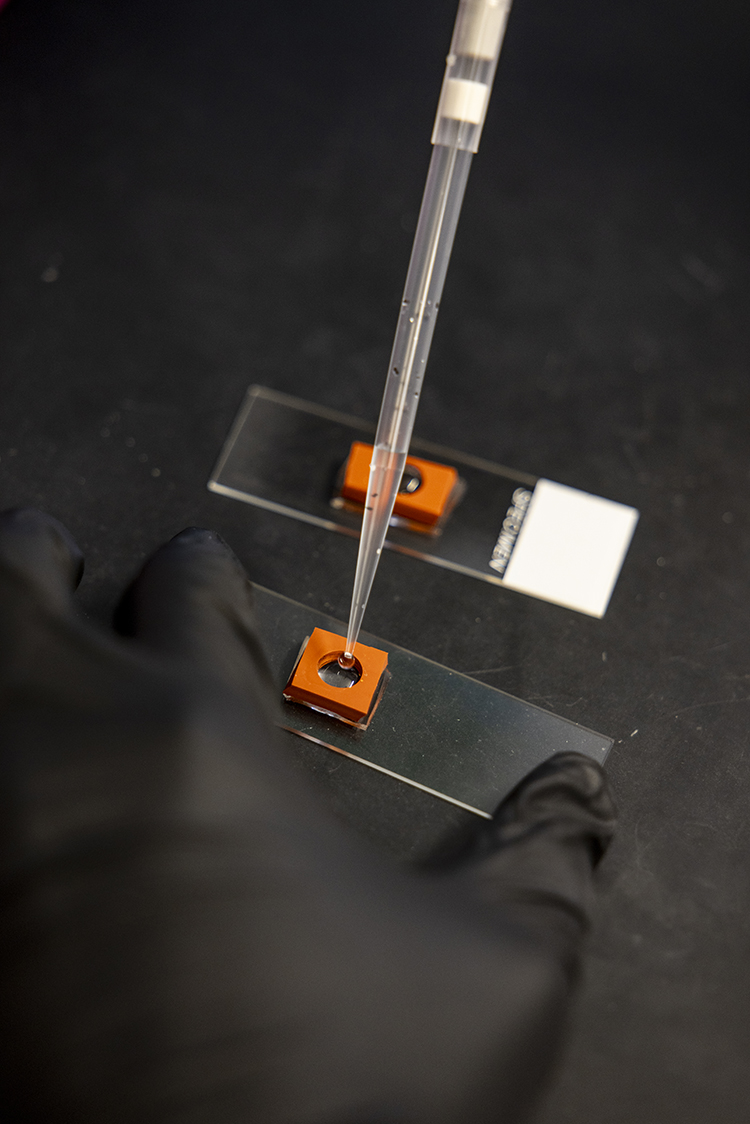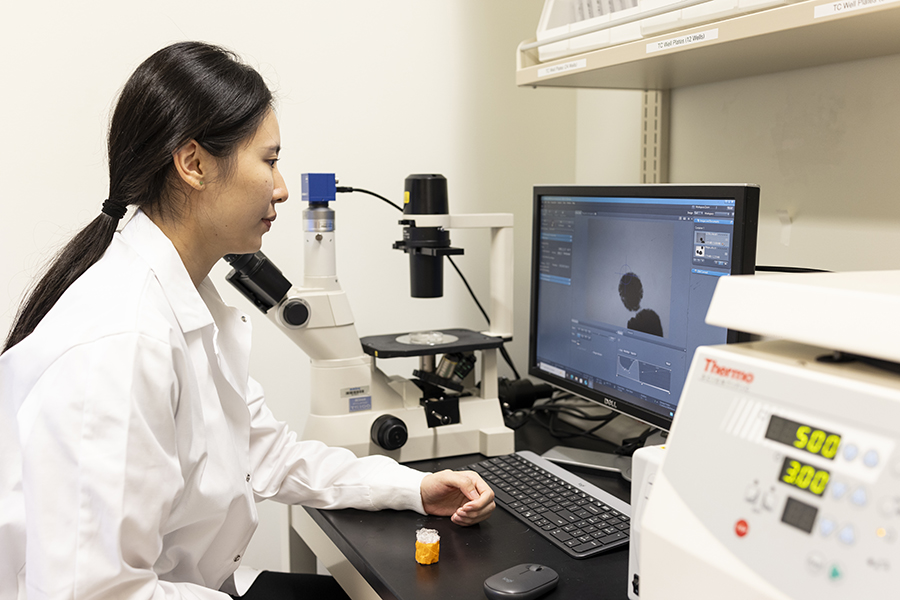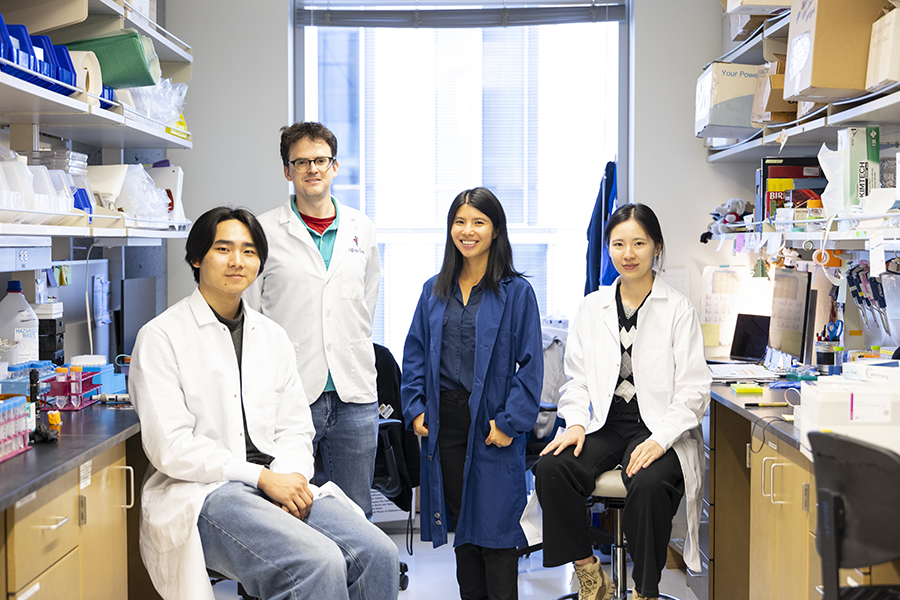The potential to regenerate limbs
ME researchers are exploring how to regenerate tissue using magnetic microgels.
Story by Lyra Fontaine
November 10, 2025
Photos by Dennis Wise/University of Washington
Top image: ME Ph.D. student Runrun Chen applies a magnet to one side of a tube with magnetic microgel particles to show their responsiveness.
About 2 million Americans have limb or digit loss from injuries or diseases. For them, the ability to restore or regenerate part of the missing limb would mean a significant improvement to quality of life. Extending the length of the bone, for example, could improve the fit of a prosthetic device.
What if we could regenerate musculoskeletal tissue and grow a limb outward using biomaterials that release growth factors, or proteins that can help form bones and joints, at controlled times and locations?
Feini (Sylvia) Qu, assistant professor in ME and the Department of Orthopaedic Surgery & Sports Medicine, received a National Institutes of Health (NIH) Trailblazer Award to explore how injectable biomaterials could lead to limb regeneration. The award provides $400,000 to new and early-stage investigators over three years to support research programs that connect life sciences with engineering and the physical sciences.
“I feel grateful to the NIH for supporting me as an early-career researcher. It’s exciting to see a project I imagined years ago become reality,” says Qu, a core faculty member of the UW Institute for Stem Cell & Regenerative Medicine (ISCRM). “We hope to figure out how to induce natural regeneration — that’s present in animals such as salamanders and certain types of fish — in people.”
Magnetic microgels for limb growth

Human tissue typically scars after injury and does not regenerate. While bone can heal and regrow, it typically does not grow outwards. Qu is interested in how musculoskeletal tissue cells might respond to the regenerative effects of growth factors.
The goal is to regenerate limbs in people, but to do that, the researchers will first use experimental models in the lab setting.
“There’s an invisible boundary where the regeneration ends and it scars over,” Qu says. “Our lab has tried to identify the important cells and signals that participate in regeneration.”
Qu’s lab is creating a platform that can precisely control when and where to release two different growth factors through injected microgels, with the goal of regenerating a digit tip.
Microgels are small spherical droplets of hydrogels, which are 3D cross-linked, water-filled polymer networks used to create items like soft contact lenses. The goal is to make these biomaterials tiny, like a grain of sand, so that they are injectable in clinical settings, and to control where the microgels are delivered by making them magnetically sensitive.
The idea for magnetic microgels came to Qu when she observed her daughter using a magnetic play table that allowed her to remotely move objects around the table.
“I thought, why can’t we do this for our biomaterials?” Qu says. “If we inject a mix of magnetic and non-magnetic microgels and put a magnet at the end of the limb, we could pull the growth factors in certain directions.”
The researchers plan to use magnetic microgels to deliver the protein that can elongate bones to the edge of the bone, then release the protein that can induce a new joint to form at the end of the new bone. The goal is to form a joint at the end of the elongated bone — a step toward regenerating a whole limb.
With initial help from collaborator Woojin Han at the Icahn School of Medicine at Mount Sinai, the Qu Lab is now successfully developing magnetic microgels. To ensure that the research is clinically relevant, Qu and her team also regularly consult with Dr. Christopher Allan, an orthopaedic hand surgeon at UW Medicine.

Exploring microgel movement
Student researchers in the Qu Lab have made valuable contributions to the project. ME Ph.D student Runrun Chen optimized and fine-tuned the fabrication process to reliably synthesize the microgels with a magnetic material and reduce the biomaterials’ size. The lab has developed microgels with different viscosity, density and other mechanical properties using biodegradable materials. Working with CoMotion, the researchers recently filed a patent application on this technology.
Chen’s experiments show that the microgels move with the magnet in a liquid environment. She also tests the biomaterials’ movement in collagen with different levels of stiffness that mimics how real-life tissue has a range of stiffness during regeneration. The team will inject the microgels loaded with regenerative proteins and track them in the tissue.
“We will inject the microgels to see whether we can achieve this regeneration,” Chen says. “I’m excited to see how this research can be applicable to humans.”
Undergraduate Martin Liu develops computational models to predict how the microgels can move through tissue. He does computational simulations using finite element analysis of how the collagen concentration affects the microgels’ movement. This work will help the team better understand how the mechanical properties of tissue affect the growth factor release rate and magnetic responsiveness.
“I enjoy contributing to the lab because the research could eventually impact human health,” says Liu. “The goal of providing better treatments for people who have had traumatic injury is inspiring to me.”
It’s rewarding to work with students and see them realize how mechanics influences biology”
The importance of mentorship
Qu decided to go to graduate school and pursue research after receiving mentoring and developing a sense of belonging in a scientific community when she was an undergrad. These experiences have made her passionate about providing mentorship throughout her career.
“It’s rewarding to work with students and see them realize how mechanics influences biology,” Qu says.
Liu found out about the Qu Lab from the annual ME open house. The research piqued his interest because of its biomedical applications. Because of his experiences in the lab, and support from a Mary Gates Research Scholarship, Liu is interested in pursuing graduate education related to the mechanics of biology and human health.
“I’ve gained skills in finite element analysis, project management and coming up with my own research questions and methods,” says Liu.
